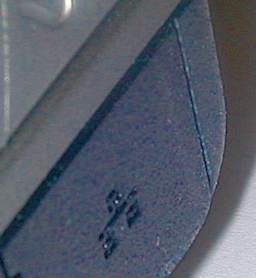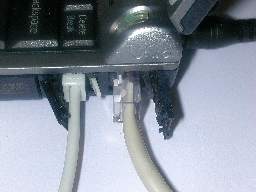I got this great Sony Vaio sub-notebook computer. It is a really kewl little computer, and actually fits into my folder case. It is designed for the “wireless on-the-go executive.” However, there is one problem. When they designed the socket for a physical (wired) Ethernet connection, they made a decision that directly affects the usability of the computer.
basically, the socket cover opens in such a manner that you have to jam your finger in between the cover and the plug in order to squeeze the tab to release the plug. Observe:



If you have very big fingers, then it will be impossible to remove the cable with your fingers. You’ll need a tool.
I guarantee that many people just rip the cover off. The others just never plug in a cable. I need to plug cables in fairly frequently, as the wired network is a LOT faster than the wireless network.
I’m pretty sure I know why they designed it this way. It probably has to do with getting at the plug while the modem port (located right next to it) is open. If you have a plug in each, then it is very awkward indeed to get at them. However, the modem port is designed to be far more accessible than the Ethernet port. This is an understandable decision. They probably decided that, since this was a travel computer, people would be plugging modems in much more frequently than they would Ethernet cables.
I beg to differ.
I travel a lot, and just about every hotel in which I stay, I use an Ethernet-based connection for high-speed Internet. In some cases, I get a wireless connection. In only a very small number of cases do I have to use the modem port, so any design that favors the modem port is, in my case, a bad design.
Now, Sony is a company that is known for good user design (funny that my first two posts are on Sony products, though.), so I am sure that this was carefully thought through. Far be it for me to second-guess them; but I will anyway.
Suggested Solutions:
Turn the Ethernet plug around.
I’m pretty sure that the reason they didn’t do this already is because there is a real danger of giving youself the “bamboo-splint-under-the-fingernail” treament if there is a wire in each connector. Maybe the risks of being sued outweigh the usability gains. I dunno. No matter which direction the Ethernet plug faces, the modem port cover is very difficult to open when there is a plug in the Ethernet port. I have to remove the Ethernet cable in order to open the modem port.
Exchange the positions of the Modem and Ethernet plugs.
This is merely a reallocation of the priorities. In my case (and, I’ll bet, in a lot of other peoples’ cases), the Ethernet cable is more important than the modem cable.